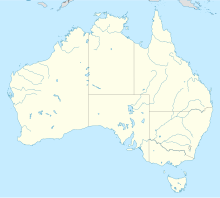Yeelirrie uranium project
| Location | |
|---|---|
| Location | Wiluna |
| State | Western Australia |
| Country | Australia |
| Coordinates | 27°10′41″S 119°54′47″E / 27.17806°S 119.91306°ECoordinates: 27°10′41″S 119°54′47″E / 27.17806°S 119.91306°E |
| Owner | |
| Company | Cameco |
| Website | Cameco website |
| Year of acquisition | 2012 (discovered 1971) |
The Yeelirrie uranium project is a uranium deposit located approximately 70 km southwest of Wiluna, in the Mid West region of Western Australia. The name Yeelirrie is taken from the local sheep station and, in the local Aboriginal language, means "place of death".
There is a proposal to mine other uranium deposits in the Wiluna area: the Lake Maitland, Centipede, Millipede and Lake Way uranium projects.
The Yeelerie uranium deposit was discovered in mid-1971 by WMC Resources. WMC reached an agreement with Esso and the German Urangesellschaft Australia Pty Ltd in 1978 to co-finance the project, which was then scheduled for production by 1984.
Work on the mine development was underway by 1980 and trial mining was carried out. A pilot precessing plant was established at Kalgoorlie in late 1980 and detiled metallurgical studies were undertaken from 1980 to 1982. A feasibility study for production at the rate of 2,500 tonnes (5.5 million pounds) of U3O8 per year was completed in August 1982. There was also potential for 1,000 tonnes per year of vanadium oxide by-product.
The succession of the Australian Labor Party to the federal government and that party's "Three mine policy" put a stop to the project by 1983. Yeelirrie was placed in care and maintenance. Site rehabilitation was completed in 2003.
The project was acquired by BHP Billiton in 2005 when it acquired WMC. BHP reactivated the project after the strongest uranium market in over 25 years and a 2008 change in government policy. The company planned to start mining at Yeelirrie by 2014, producing approximately 80 tonnes (0.18 million pounds) of uranium oxide per week. The mine was expected to have a life of 20–40 years. Ore would be treated on site and then transported by road to Kalgoorlie, from where it would be railed to either South Australia or the Northern Territory, where there are established facilities to store and export uranium oxides.
...
Wikipedia

